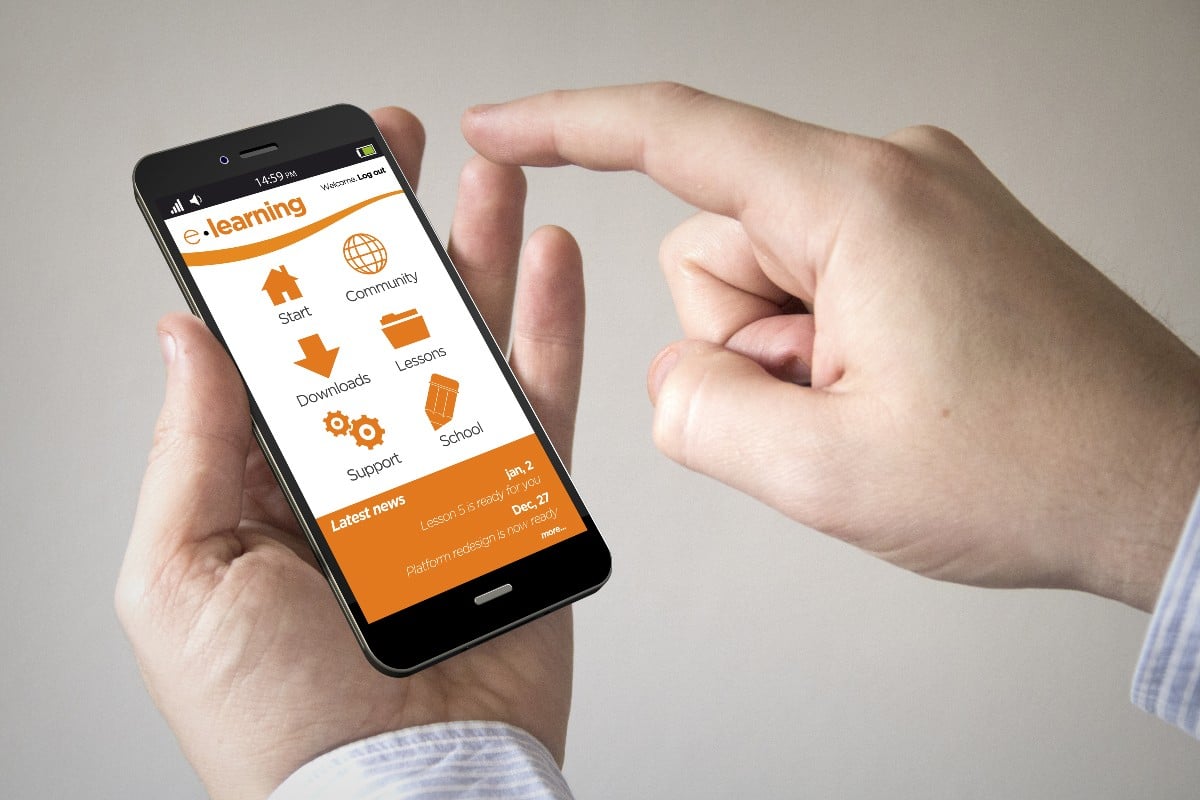Easier, faster, more accessible: mobile learning, or M-learning, has revolutionized the world of training and is becoming increasingly more popular with companies. But what exactly is it? What are its advantages and disadvantages? Let’s take a deep dive and find the answers.
Defining mobile learning
Mobile learning is a professional training tool based on mobile devices such as smartphones and tablets. It allows learners to access their training content any time and from any location.
What are the modalities of mobile learning?
An M-learning course is distinguished by its accessibility, but also by its interactive, fun and personalised content.
It offers numerous techniques that can be used to help employees achieve their goals and acquire new skills, such as:
- Microlearning: this learning method consists of very short modules (usually less than 5 minutes). Available at any time, they are focused on a specific concept in order to maximize the memorization of information.
- Peer learning: it aims to encourage exchanges between learners, who become real actors in their training. Also known as social learning, it allows employees to share their experiences and knowledge via a forum, a chat or a corporate social network.
- Adaptive learning: this is mobile learning adapted to the needs, desires and preferences of each learner, for total personalization.
- Virtual reality and augmented reality: they allow learners to be immersed in a virtual world and to create very realistic situations.
- Blended learning: this combines digital learning and face-to-face training to get the best out of both methods.
What are the benefits of mobile learning?
As evidenced by its growing popularity, M-learning has many advantages for companies.
A remote learning solution
With a mobile learning solution, learners can follow their training path anywhere, at any time and from any device: phone, tablet, laptop… Moreover, learning can be done online or offline.
It is therefore an ideal tool for professionals on the go, who travel frequently and whose schedule does not allow them to attend face-to-face training.
Moreover, M-learning makes it possible to make good use of travel time, which can be devoted to learning.
Flexible digital training
The secret of successful training is to meet the expectations of each learner.
The flexibility of mobile learning allows employees to learn at their own pace and to focus on certain concepts. Thus, each person advances in their own way and on their own time, whereas a face-to-face course requires several employees to be brought together in a set time slot.
A motivating learning method
Mobile learning has another important advantage: it keeps learners motivated in the long term.
Indeed, it is based on an intuitive and easy-to-use learning platform (called a Learning Management System), which makes all training content available.
In addition, mobile learning is conducive to storytelling, with the use of immersive situations and scenarios. This is the way to keep employees interested with effective and addictive training, while optimizing the assimilation of skills.
Finally, gamification is an integral part of m-learning. The company can offer training in the form of games, but also integrate a points and ranking system. In this way, the most assiduous learners are rewarded and a positive competitive spirit emerges among the employees, who become even more involved in their training.
What are the disadvantages of mobile learning?
Despite its many advantages, mobile learning has limitations that are important to be aware of before embarking on it.
Mobile learning can be distracting
Mobile devices are great learning tools, but they can also be a major distraction. Employees who train independently must, therefore, be self-disciplined to really focus on their training.
The introduction of a points system, whereby employees are ranked according to their attendance, is a good way to address this problem. Indeed, this positive competition encourages learners to invest fully in their training.
Training is more difficult to control
The greater freedom offered to learners raises another problem: it is difficult for the employer to monitor the progress of their training.
One way of dealing with this is to take stock on a regular basis, through group meetings or individual interviews. However, this approach is quite time-consuming..
Another possibility is to set up questionnaires or evaluation tests at the end of the training modules. In this way, the employer can ensure that employees have assimilated the key knowledge and skills.
M-learning can infringe on employees’ privacy
Finally, mobile learning raises questions about the distinction between private and professional life.
In the case of traditional face-to-face training, the lessons are given during the employees’ working hours. On the other hand, a mobile learning tool can be used at any time, including during rest periods.
The company must therefore ensure that it sets aside time for training, to avoid any encroachment on employees’ personal lives.
International e-learning: we’re here!
Popular in France, mobile training applications are also popular internationally. Whether it is a webinar for which presentations need to be translated or a multilingual sales training module, the translation must be adapted to both the target audience and the chosen training medium.
To ensure that no aspect of this project is overlooked, the wisest solution is to entrust the translation of training materials to a translation agency specializing in e-Learning. Tradonline’s expert translators are able to adapt to the different formats and specifications of e-learning platforms.
Flexible and customizable, mobile learning is a learning method adapted to the needs and constraints of today’s companies. But it is also an excellent tool to motivate employees towards continuous learning and developing their skills in the long term.

